

Story by Cathi Douglas '80 | Images by Jeanine Hill and Karen Tapia
All it took was one crack of Indiana Jones’ whip and Ed Knell was hooked. Being an archaeologist like in the 1981 film “Raiders of the Lost Ark” was exhilarating, sensational, and combined Knell’s love of puzzles and fascination with mysteries.
Years later, Knell – today a Cal State Fullerton assistant professor of anthropology – is embarking on the discovery of a lifetime. Like Jones, he is unearthing ancient artifacts never before seen by modern man.
Knell and a team of other university scientists are involved in the curation and preservation of Orange County’s vast archaeological and paleontological collection, portions of which date back 60 million years. The collection includes both artifacts – such as grinding stones and hand stones about 8,000 years old – and fossils – including fully articulated marine life tens of millions of years old.
“This tells us about the past in Orange County,” Knell said. “It is a nice snapshot of the suite of historic behaviors that capture the past. It gives us a better understanding of where we live.”
For the past 35 years, the county of Orange has collected hundreds of thousands of artifacts, specimens and objects associated with archaeological and paleontological investigations throughout the county.
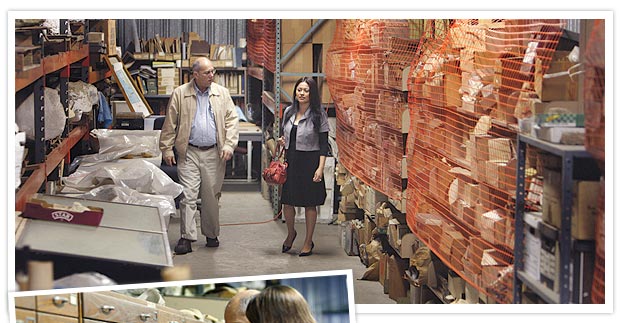 |
|
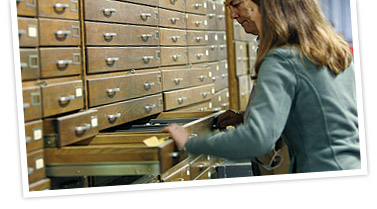 |
Above: Professor John Foster and Griselda Castillo, historical programs manager for the Old Courthouse/OC Historical Commission, stroll through a corridor in the county’s John D. Cooper Archaeological and Paleontological Center. Left: Foster works with Meredith Rivin, LSA Associates Inc. laboratory director, in the county center. |
A December 2009 agreement between the county and Cal State Fullerton authorizes the university to assume day-to-day management and curation of the county’s Archaeological/Paleontological Collection and provides funds to help underwrite the work through 2013.
Cal State Fullerton will provide separate professional archaeological and paleontological teams supplemented by volunteers to study and prepare items for eventual public display. The collection will remain at an archaeological and paleontological center owned by OC Parks in Santa Ana. The center, now undergoing renovation designed to enhance curation work, is named in honor of the late John D. Cooper, a professor emeritus of geological sciences, who was dedicated to preserving the collection.
In support of the effort, the Cal State Fullerton Philanthropic Foundation board has adopted the archaeological and paleontological project as one of its five fundraising initiatives, striving to both support the initial curation activities and fund long-term goals, such as the public display of artifacts and fossils.
“Engaging in the important work of preserving our past and bringing it to life presents an unparalleled opportunity for students in college,” said Pamela C. Hillman, vice president of University Advancement and the foundation’s executive director. “As these prospective geologists and anthropologists join accomplished educators and other professionals, the result is an amazing and enriching academic experience.”
Understanding the past means affording these students, researchers and the public opportunities to study the collection. Depending upon available funding, the collection will be shared in the future at exhibits and in K-12 classrooms, including through a mobile dig trailer – a customized museum on wheels – and an interactive website. Ultimately, the university will seek an endowed chair to manage the effort with optimum effectiveness and maximize opportunities for the public to access and understand the collection.
“The university is the ideal partner in this effort,” said OC Parks Director Mark Denny ’92 (B.A. political science). “With the only program of its kind in Orange County, this is a unique public partnership. Ultimately, there will be terrific public benefit.”
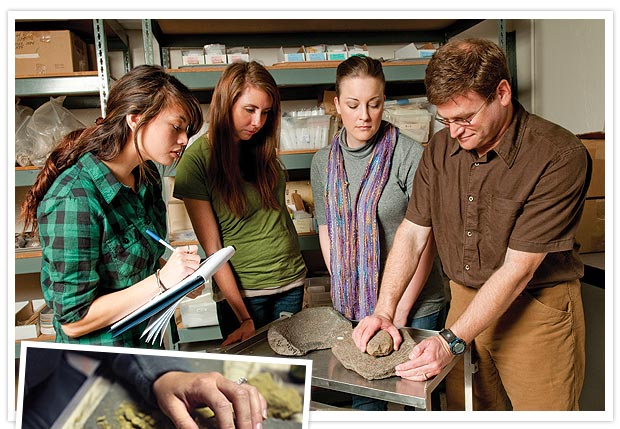 |
|
 |
Above: Professor Ed Knell demonstrates a grinding stone with, from left, students Laura Morales, Allison Hill and Bethany Abram. Left: Rivin works with artifacts from the county’s collection. |
In addition to significant support from the county, private financial support will play a critical role in ensuring the success of this initiative. Current fundraising plans call for $1 million for purchase and outfitting of the mobile dig trailer, and $100,000 annually to operate the trailer. Following the initial efforts, attention will be paid to an endowment to ensure the long-term viability and growth for the initiative.
“This collection has worldwide significance, with perhaps the most spectacular finding of marine mammals, including unique species,” said John Foster, professor of geological sciences. “It indicates the importance of our heritage, the development of our society. It shows us the sequence of life.”
The collection features marine life – such as whales, porpoises and sea lions – not found anywhere else, including evolutionary links, noted Nicole Bonuso, assistant professor of geological sciences. “This collection shows us a unique part of our deep-time history,” she said. “It shows us what this place looked like 60 million years ago. We’re talking about tens of millions of years – that vastness of time is hard to grasp.”
Lifetimes of research could stem from the collection, said David Bowman, associate professor and chair of the Geological Sciences Department.
“This is an amazing, world-class collection of fossils representing an unparalleled collection of marine life from that time period.”
At Cal State Fullerton, bringing the past to life also includes creating a vital historical narrative of Southern California’s diverse and complex human experience by recording the oral histories of those who’ve witnessed historic times and events.
Along with the archeological and paleontological project, the Center for Oral and Public History is a Cal State Fullerton Philanthropic Foundation strategic fundraising initiative. The Center for Oral and Public History has recorded more than 5,000 oral histories, the largest collection in the state, during its more than 40-year history. Global in scope and yet distinctive for its grassroots nature, the center’s focus has been on students collecting the histories of everyday people rather than well-known public figures.
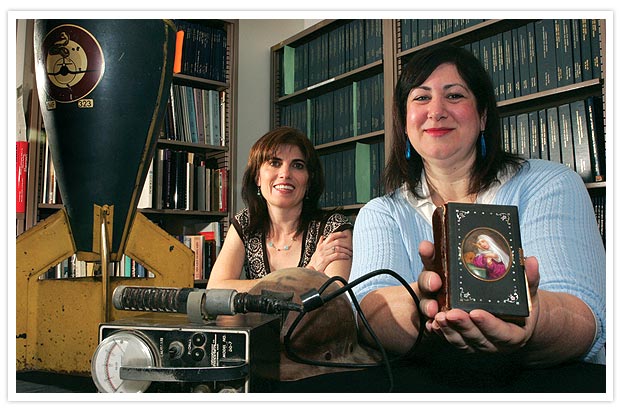
Above: Professor Natalie Fousekis, left, and Stephanie George, archivist, display an 1850 prayer book that is part of the Yorba Family Collection; an ash tray crafted from a bombshell casing from the El Toro Marine Corps Air Station; and a Geiger counter donated to the uranium mining collection.
Below: United States Marine Corps Women Reserves in formation at MCAS El Toro in 1945.
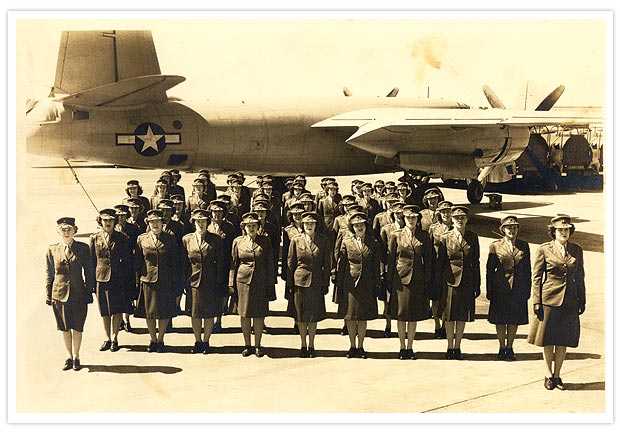
“Our center gives voice to the experience of the average Southern Californian,” said Natalie Fousekis, director of the center and an associate professor of history. “We have a passion for stories in the community.”
Art Hansen, immediate past director of the center and a professor emeritus of history, agreed. “We are essentially giving people the gift of self-reflection.”
The center’s collections reflect the region’s ethnic and cultural diversity. Notable projects have focused on the county’s proud Japanese heritage, its agricultural past, its Mexican-American citizenry, its significant Vietnamese-American population and President Richard Nixon’s early life. Some collections focus on critical moments in residents’ lives before they migrated to Southern California, such as the European Experience During World War II project, an effort led by center associate director Cora Granata.
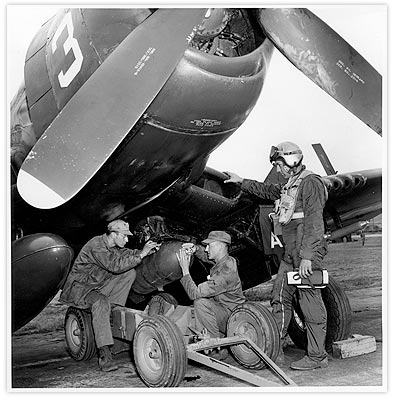
Above: Colonel Richard Watson
supervises repairs to his aircraft,
circa 1951.
For that project, which began in a Modern European History class, students identified survivors of the war now living locally. “We wanted the European Experience collection to focus both on civilians and combatants, adults and children during the war, all sides of the conflict,” said Granata, an associate professor of history. “We wanted a broad swath. It’s important to hear the multitude of voices.”
One example of the center’s continuing efforts is the El Toro Marine Corps Air Station Oral History Project, a multi-year, multi-phase project in association with the Great Park Corporation. In it, the center is recording the memories of those who were stationed at the base, worked at the base, or lived in the surrounding communities from World War II until El Toro began its transformation into the Great Park. A second recently launched project will chronicle the beginnings of the fast-food industry in Southern California and its important family dynasties, such as the Carl Karcher family and the families that established In-N-Out Burger, Taco Bell and more.
With all of these projects, the center’s students and faculty are finding diverse ways of bringing these oral histories to the public through oral-history-based performances and exhibitions. Two of the center’s associate directors, Ben Cawthra and Ray Rast, work with students to mount public exhibitions of the center’s collections.
But the center’s efforts are threatened, because it requires funds to make its collections accessible online, provide adequate space for students to collaborate on both oral and public history projects, and most important, a climate-controlled atmosphere in which to protect its valuable historical resources. The foundation board and center staff members are reviewing specific plans to see what investments will be needed. It is anticipated that ultimately at least $4 million will be sought to support the Center for Oral and Public History’s efforts.
“These stories are at risk of being lost,” Fousekis said.
“The best way to ensure they are safe is with a climate-controlled archival space. In the future, the bulk of the collection will be digitized and backed up, increasing online access to the collection for scholars worldwide.”
Donors to the center have an opportunity to support the efforts of a sacred trust, said Cawthra, an assistant professor of history. “The collection will be here in perpetuity for scholars and the future,” he said. “We want to do everything we can to make good on that promise.”
The value of the collection is that “it represents so many different voices, from so many different eras, experiencing so many different events,” said Stephanie George, the center’s archivist.
“In listening to these voices, history is a little more tangible than just words on a page. We can hear someone speaking, the inflection in their voice, and interpret what the events meant to them. We can put ourselves in their shoes.”
For future generations, the collection represents the opportunity to connect personally with the past.
“There are 5,000 voices whispering to us, screaming to us, constantly talking to us,” noted Rast, assistant professor of history. “It’s a raising of historical consciousness, a connection
to both the past and the future.” ![]()